Amazon SQS
This is not an exhaustive documentation of all the existing AWS Services. These are summarized notes that I used for the AWS Certifications.
To see the complete documentation, please go to: AWS documentation
Simple Queue Service (SQS)
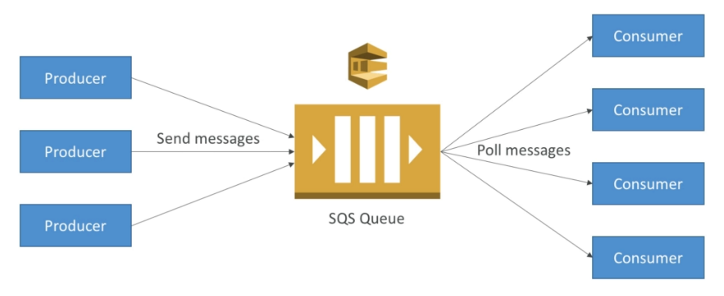
Standard Queue
- Oldest offering on AWS (over 10 years old).
- Fully managed service, used to decouple applications.
- Can have duplicate messages (at least once delivery).
- Can have out of order messages (best effort ordering).
- Attributes:
- Unlimited throughput.
- Unlimited number of messages in the queue.
- Each message is short leaved:
- default retention period is 4 days
- maximum is 14 days
- Low latency:
- Less than 10 ms on publish and receive
- Limitation for message size:
- maximum size of a message is 256KB
Delay Queue
- Delaying a message means the consumers wont be able to see the message for a period of time after it was sent.
- Delay time can be up to 15 minutes.
- Delay can be set at a queue level or tt also can be set to message level using the DelaySeconds parameter
FIFO Queue
-
FIFO - First In First Out
-
The messages will be ordered in the queue, meaning that the messages will be consumed in the same order as they were sent.
-
FIFO queues have limited throughput: 300 msg/s without batching, 3000 msg/s with batching.
-
Exactly-once send capability (by activating content-based deduplication).
-
The name of the FIFO queue must end with the
.fifo.
Producing Messages
-
Producers send messages to the queue using the SDK (SendMessage API).
-
The message is persisted on the queue until a consumer deletes it.
-
Message retention: default 4 days, up to 14 days.
-
SQS standard has unlimited throughput.

Consuming messages
-
Consumers are applications (running on EC2 instances, other servers or AWS Lambda).
-
Consumers poll the queue for messages (they can receive up to 10 messages at a time).
-
After the messages are processed the consumers delete the messages from the queue using DeleteMessage API.
-
Multiple consumers:
- Consumers receive the messages in parallel.
- Each consumer consumes a fraction of the number of the messages sent.
- We can scale the number of the consumers based on the throughput of processing.
-
SQS with Auto Scaling Group:
- We can scale based on the ApproximateNumberOfMessages metric by creating a CloudWatch alarm.

Message Visibility Timeout
- After a message is polled by a consumer, it becomes invisible to other consumers.
- Default message visibility timeout is 30 seconds, which means the consumer has 30 seconds to process the message.
- After the message visibility timeout is over, the message becomes visible to other consumers.
- If the processing is not finished during the visibility timeout, there is a chance the message will be processed twice.
- If a consumer knows that the processing wont finish in time, it can use the ChangeVisibility API to request more time.
- If the message visibility timeout is high and the processing fails, it may take a long time for the message to be processed again.
- If the visibility timeout it too short, we may end up processing the same message twice.
- Best practice: the visibility timeout should be set to something appropriate.
- The consumer must be implemented in a way to use the ChangeVisibility API.
Dead Letter Queues
-
If a consumer fails to process a message within the visibility timeout, the messages goes back to the queue. This can happen multiple times.
-
We can set a MaximumReceives threshold, which denotes how many time a message should be able to go back to the queue.
-
If the MaximumReceives threshold is exceeded, the message is sent to a dead letter queue
-
DLQs are useful for debugging.
-
We have to make sure the messages are processed in DLQ before expiring. It is not a good idea to set a short expiration time for the DLQ.
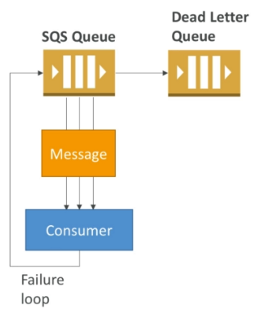
Long Polling
-
When a consumer requests messages from the queue, it can optionally wait for messages to arrive if there are none in the queue.
-
Long polling decreases the number of API calls made to SQS while increasing efficiency.
-
Wait time can be between 1 sec to 20 sec.
-
Long polling is preferable than short polling.
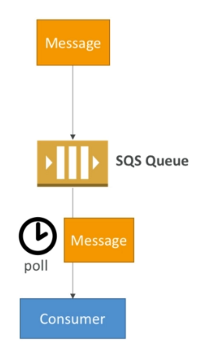
Message Consumption Flow
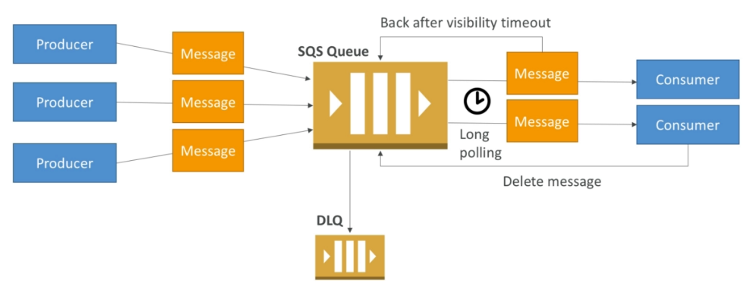
SQS With Auto Scaling Group
Allows scaling the number of EC2 instances based on the available messages in the queue.
-
In order to accomplish auto scaling we have to create a CloudWatch custom metric representing the number of available messages on the queue divided by the number of EC2 instances.
-
This metric is pushed from an EC2 instance
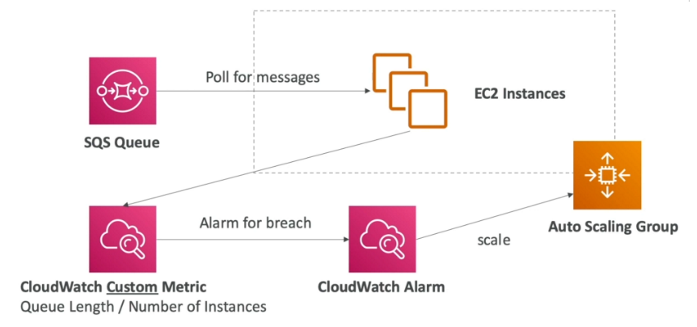
If the variable goes above the threshold value, this may mean:
- There are many messages, or
- There are not enough instances to process those messages.
When we set the threshold value, we can set maybe set TWO ALARMS:
- When variable is below threshold value
- When variable is above threshold value
When the variable goes above the threshold value, then alarms are breached and it will do the following:
-
Cloudwatch alarm can be assigned with a scaling policy on your ASG.
-
It can scale your ASG accordingly.
SQS Extended Client
-
Message size limit is 256KB, how to send large messages?
-
For this, use SQS Extended CLient (Java library)

Decouple application tiers

Data Ordering in SQS
- For standard SQS queues there is no data ordering.
- For SQS FIFO, if we don't use a Group ID, messages are consumed in the order they are sent, with only one consumer.
- Messages can be group by specifying a Group ID for the message.
- For each group we can have different consumers, which will read messages in order.
Security
-
Encryption
- In-flight encryption using HTTPS.
- At-rest encryption using KMS.
- Client-side encryption if the client wants to perform encryption/decryption itself.
-
Access Control
- IAM policies to regulate access to the SQS API.
-
SQS Access Policies
- Useful for cross-account access to SQS queues.
- Useful for allowing other services (SNS, S3) to write to an SQS queue.